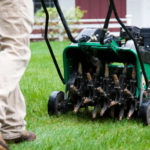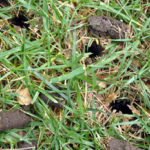Get a Healthy Lawn – Aerate
An important part of building a healthy lawn often overlooked is aeration. As important as watering and fertilizing your lawn, aeration ensures critical nutrients get to the soil beneath the grass roots. Grass can then draw upon those nutrients to build strong root systems, fight the encroachment of weeds and survive during periods of drought.
Your yard could benefit from aeration if:
- it is heavily used, even children and family pets can contribute to compacting soil.
- the yard is thatched greater than a half inch.
- the grass was laid as a part of new home construction. Construction traffic is a major contributor to soil compaction.

Plug aerator via lawnmarkplus.com
These conditions all indicate a need for aeration; in any case, it should be considered a part of your yearly maintenance plan.
There are two types of aerating tools – plug and spike aerators. Plug aerators remove a core of soil from the ground, spike aerators punch holes in the ground. Of the two, plug aerators are recommended. The spike method can add to soil compaction, defeating the purpose of aeration. Aerators can usually be rented from garden or equipment rental stores. Be sure to take a friend along, they can be quite heavy, and you can share the cost if you convince your friend to use the machine as well. Before starting work be sure to mark any underground sprinkler heads. There’s nothing worse than creating extra work for yourself by puncturing a sprinkler head!
It’s important to aerate the yard when the soil is moist, plan on working after a rain shower or after watering your lawn. If using a plug aerator, don’t worry about the plugs left in the yard. They will dry and break up; or, if you just can’t stand the look for a short time, rake them up and put them into a compost pile. Your normal mowing will also break them up, but you might need to sharpen the mower blades before the next cycle.
After aeration continue with your normal yard maintenance schedule: water and fertilize.

Aeration plugs via Kansas State Univ
Avoid aerating when the grass is dormant. Aerate when the grass is in its growing season, late April or May is a perfect time. Aerating the yard is not a difficult task, and you will find your lawn will be thicker, healthier and the envy of your neighbors. If you’ve never aerated or haven’t done it in the last couple of years, give it a try. You won’t be sorry.
Written by Cliff Blackerby, Master Gardener. March 2020.